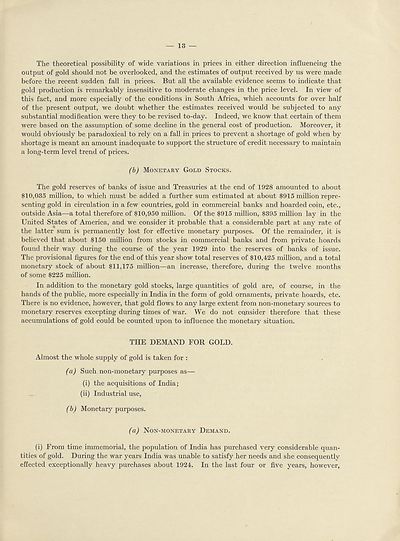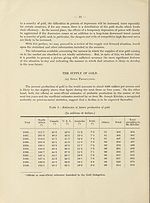Economic and financial section > Interim report of the Gold Delegation of the Financial Committee
(15)
Download files
Complete book:
Individual page:
Thumbnail gallery: Grid view | List view

13
The theoretical possibility of wide variations in prices in either direction influencing the
output of gold should not be overlooked, and the estimates of output received by us were made
before the recent sudden fall in prices. But all the available evidence seems to indicate that
gold production is remarkably insensitive to moderate changes in the price level. In view of
this fact, and more especially of the conditions in South Africa, which accounts for over half
of the present output, we doubt whether the estimates received would be subjected to any
substantial modification w'ere they to be revised to-day. Indeed, we know that certain of them
were based on the assumption of some decline in the general cost of production. Moreover, it
would obviously be paradoxical to rely on a fall in prices to prevent a shortage of gold when by
shortage is meant an amount inadequate to support the structure of credit necessary to maintain
a long-term level trend of prices.
(b) Monetary Gold Stocks.
The gold reserves of banks of issue and Treasuries at the end of 1928 amounted to about
810,035 million, to which must be added a further sum estimated at about $915 million repre¬
senting gold in circulation in a few countries, gold in commercial banks and hoarded coin, etc.,
outside Asia—a total therefore of $10,950 million. Of the $915 million, $395 million lay in the
United States of America, and we consider it probable that a considerable part at any rate of
the latter sum is permanently lost for effective monetary purposes. Of the remainder, it is
believed that about $150 million from stocks in commercial banks and from private hoards
found their way during the course of the year 1929 into the reserves of banks of issue.
The provisional figures for the end of this year show total reserves of $10,425 million, and a total
monetary stock of about $11,175 million—an increase, therefore, during the twelve months
of some $225 million.
In addition to the monetary gold stocks, large quantities of gold are, of course, in the
hands of the public, more especially in India in the form of gold ornaments, private hoards, etc.
There is no evidence, however, that gold flows to any large extent from non-monetary sources to
monetary reserves excepting during times of war. We do not consider therefore that these
accumulations of gold could be counted upon to influence the monetary situation.
THE DEMAND FOR GOLD.
Almost the whole supply of gold is taken for :
(a) Such non-monetary purposes as—
(i) the acquisitions of India;
(ii) Industrial use,
(b) Monetary purposes.
(a) Non-monetary Demand.
(i) From time immemorial, the population of India has purchased very considerable quan¬
tities of gold. During the war years India was unable to satisfy her needs and she consequently
effected exceptionally heavy purchases about 1924. In the last four or five years, however,
The theoretical possibility of wide variations in prices in either direction influencing the
output of gold should not be overlooked, and the estimates of output received by us were made
before the recent sudden fall in prices. But all the available evidence seems to indicate that
gold production is remarkably insensitive to moderate changes in the price level. In view of
this fact, and more especially of the conditions in South Africa, which accounts for over half
of the present output, we doubt whether the estimates received would be subjected to any
substantial modification w'ere they to be revised to-day. Indeed, we know that certain of them
were based on the assumption of some decline in the general cost of production. Moreover, it
would obviously be paradoxical to rely on a fall in prices to prevent a shortage of gold when by
shortage is meant an amount inadequate to support the structure of credit necessary to maintain
a long-term level trend of prices.
(b) Monetary Gold Stocks.
The gold reserves of banks of issue and Treasuries at the end of 1928 amounted to about
810,035 million, to which must be added a further sum estimated at about $915 million repre¬
senting gold in circulation in a few countries, gold in commercial banks and hoarded coin, etc.,
outside Asia—a total therefore of $10,950 million. Of the $915 million, $395 million lay in the
United States of America, and we consider it probable that a considerable part at any rate of
the latter sum is permanently lost for effective monetary purposes. Of the remainder, it is
believed that about $150 million from stocks in commercial banks and from private hoards
found their way during the course of the year 1929 into the reserves of banks of issue.
The provisional figures for the end of this year show total reserves of $10,425 million, and a total
monetary stock of about $11,175 million—an increase, therefore, during the twelve months
of some $225 million.
In addition to the monetary gold stocks, large quantities of gold are, of course, in the
hands of the public, more especially in India in the form of gold ornaments, private hoards, etc.
There is no evidence, however, that gold flows to any large extent from non-monetary sources to
monetary reserves excepting during times of war. We do not consider therefore that these
accumulations of gold could be counted upon to influence the monetary situation.
THE DEMAND FOR GOLD.
Almost the whole supply of gold is taken for :
(a) Such non-monetary purposes as—
(i) the acquisitions of India;
(ii) Industrial use,
(b) Monetary purposes.
(a) Non-monetary Demand.
(i) From time immemorial, the population of India has purchased very considerable quan¬
tities of gold. During the war years India was unable to satisfy her needs and she consequently
effected exceptionally heavy purchases about 1924. In the last four or five years, however,
Set display mode to:
![]() Universal Viewer |
Universal Viewer | ![]() Mirador |
Large image | Transcription
Mirador |
Large image | Transcription
Images and transcriptions on this page, including medium image downloads, may be used under the Creative Commons Attribution 4.0 International Licence unless otherwise stated. ![]()
| League of Nations > Economic and financial section > Interim report of the Gold Delegation of the Financial Committee > (15) |
|---|
| Permanent URL | https://digital.nls.uk/190953340 |
|---|
| Shelfmark | LN.II |
|---|
| Description | Over 1,200 documents from the non-political organs of the League of Nations that dealt with health, disarmament, economic and financial matters for the duration of the League (1919-1945). Also online are statistical bulletins, essential facts, and an overview of the League by the first Secretary General, Sir Eric Drummond. These items are part of the Official Publications collection at the National Library of Scotland. |
|---|---|
| Additional NLS resources: |
|

